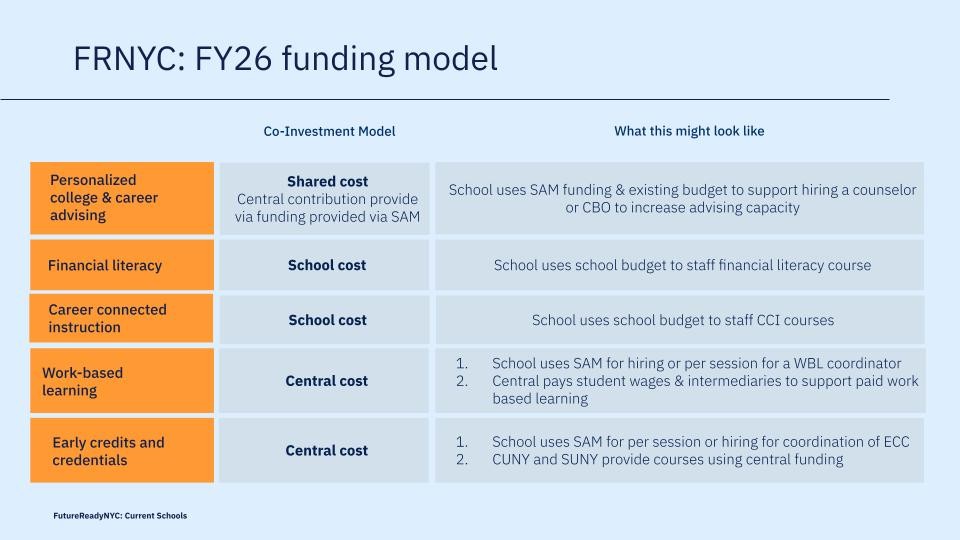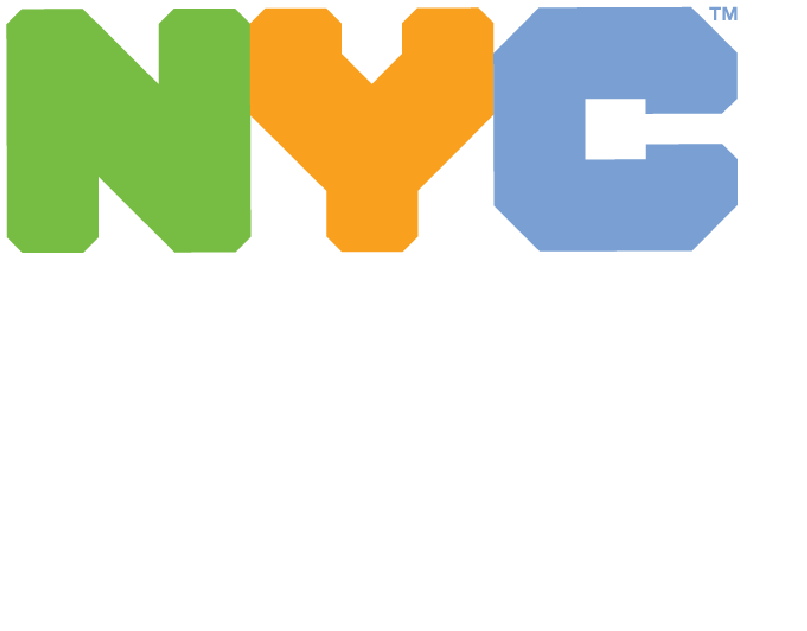Purpose of Funding
The FutureReadyNYC (FRNYC) allocation supports schools selected via a competitive application to develop programs that integrate the best of college and career pathways. Funding supports program implementation including training, staffing, professional services, and instructional resources. Participating schools receive funding to develop and maintain labor market-aligned career-connected pathways where students enroll, engage and complete five key student experiences, referred to as five pillars of FutureReadyNYC: (1) career-connected instruction, (2) paid work experiences, (3) early college credit and/or an industry-recognized credentials, (4) financial literacy, and (5) personalized college and career advising.
Students who participate in FutureReadyNYC will select their pathway after participating in career exploration and readiness coursework in 9th grade and will commit to engaging in all elements of FutureReadyNYC programming. School funding will be based on the implementation model (first year or full implementation). The funding will support full implementation for schools in cohort 1 (started implementation in SY2022-2023), cohort 2 (started in SY2023-2024), and cohort 3 (started in SY2024-2025). Cohort 4 schools starting in SY2025-2026 will receive first-year implementation funding.
The Career Readiness and Modern Youth Apprenticeship (CRMYA) allocation is based on schools selected to participate in a program that incorporates universal career readiness, pre-apprenticeships, and apprenticeships to provide a head start for college and careers while in high school. Funding will support program implementation including staff time, staff time specifically for credit acceleration, professional development, work-based learning extension certification, and instructional resources. This funding supports CRMYA schools that are not in the FutureReadyNYC portfolio. Schools with both CRMYA and FRNYC will be expected to use FRNYC funding to support CRMYA. This fiscal year (FY26) is the final year of CRMYA funding outside of FRNYC.
Allocation Methodology
FutureReadyNYC
First Year Implementation Schools: Schools in Cohort 4, which are starting FutureReadyNYC beginning in SY25-26 and are considered First Year Implementation Schools, will be funded up to $110,427 (approximately $155,000 inclusive of fringe) to launch and sustain a FutureReadyNYC program. Through this funding, schools will be expected to support all 9th graders to complete universal expectations and at least 25 10th graders in specific FRNYC programming and coursework. This funding is designed to support start-up costs/FTE headcount associated with new coursework and coordination of work-based learning and early college coursework. CTE Designated schools and portfolio schools will receive modified funds of $50,000 for the first year of implementation. Schools that are new to the program submitted a spending plan as part of their FRNYC application specifically for this funding and will submit a final version of their budget once funding is confirmed and feedback is provided on their original submission.
- College and Career Advising Funding: First-year implementation schools received separate funding via the College and Career Advising allocation of this SAM to support their ongoing college and career advising activities. These schools will receive a separate spending plan for college and career funding activities and should adhere to expectations outlined in that section of this SAM.
Full Implementation Schools: Full implementation schools are funded on a per-student basis. As noted in previous communications, full implementation schools will be expected to absorb the instructional costs of FutureReadyNYC in their school budgets starting this year. This funding is calculated to support:
- ~50% of an FTE college & career advisor at a ratio of 250 students:1 based on FY25 school enrollment
- ~100% of an FTE work-based learning and early college credit coordinator at a ratio of 125 students:1 for schools based on projected for FRNYC enrollment for FY26
- Funding for per session and OTPS to support program implementation
- $50,000 in one time funding for schools starting new pathways
- Funding minimums/maximums:
- Small schools receive no less than $110K.
- Large schools receive no more than $300K for advising and no more than $610K in total.
- CTE dedicated schools and portfolio schools receive $50K given funding received through Fair Student Funding (FSF).
Schools are encouraged, in line with the above guidance, to use funding for capacity/hiring of advising staff and pedagogical staff that can support the truly new activities associated with FutureReadyNYC. Experiences are also supported via central budget, including work-based learning experiences and early college credit; this co-investment model includes:

Career Readiness & Modern Youth Apprenticeship
Schools implementing only CRMYA will receive $20,000 in funding for the coming school year.
Schools selected via application to implement both FRNYC and the CRMYA programs are expected to use FRNYC funding to cover any CRMYA expenses as the programs should be fully integrated with one another. This includes both CTE and non-CTE schools participating in FRNYC.
CRMYA was established as a three-year pilot and all funding associated with CRMYA is considered launch funding; as such, FY2026 will be the final year of this launch funding. Funding during the pilot period will have supported teacher training, supplies and any other costs associated with starting a new program. In FY2027 and beyond, the expectation is that career connected coursework (Career Exploration, Career Development and Pathway Matching courses) will continue and schools will prioritize apprenticeships as a high-quality post-secondary option. However, the implementation is expected to be close to cost neutral to schools due to the frontloading of teacher training and start-up costs. The Office of Student Pathways will work with schools to ensure CRMYA programming is sustainable based on the training and structures delivered and created in the first three years of the pilot. Schools that do not meet implementation expectations will lose access to apprenticeship opportunities.

